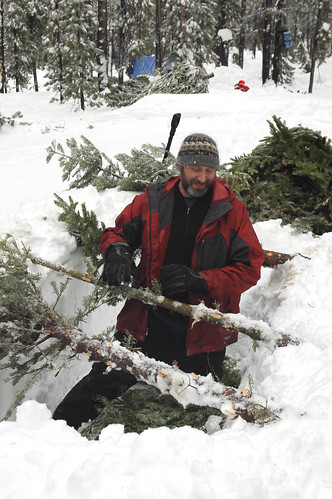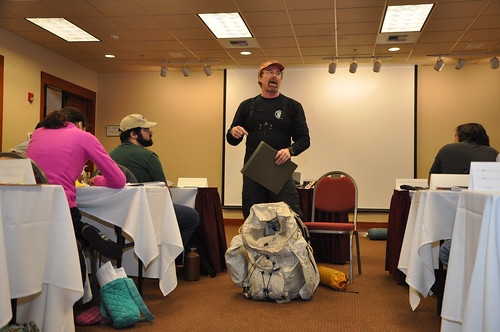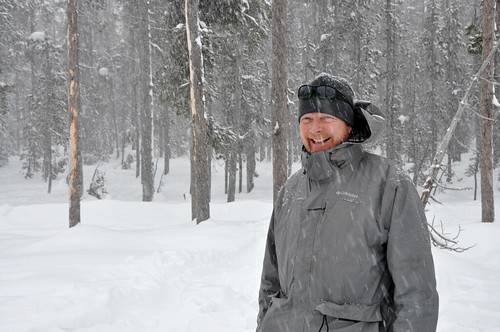
Students attending the Westwide Snow Survey Training, in Bend, Oregon this year, construct their own snow shelters and spend the night in them. Training covers a variety of topics focused on outdoor survival. Photo by Jenn Cole.
On a sunny January morning in 2010, Tony Tolsdorf had no idea that a walk in the woods would become the longest night of his life.
“It was really warm that morning, probably 55 or 60 degrees,” he recalls. “It was one of those days where you just have to get outside and do something, so I went for a hike in the Columbia River Gorge.”
His plan was to hike on a creek side trail for about seven miles, then climb onto a ridge and hike back toward his car.
All was well along the trail—aside from a few tricky stream crossings—but when he crested the ridge to begin the return, he found the landscape covered in snow.
“I was a little surprised to see all the snow, but I thought I was OK because there was a hard crust on top and I had a good grip,” Tony said. “So I kept hiking on the snow, but then it started getting really soft, and I was moving extremely slow. Pretty soon I was knee-deep.”
He decided to get off the trail and bushwhack his way to a lower elevation, but course that action brought a new challenge: climbing over an icy boulder field.
“I made it down out of the snow, but I was getting worn out and I was losing day light,” he recalled. “I had expected to be back to the car by then.”
That’s when Tony realized he needed to shelter overnight.
“I had already made a ton of mistakes up to that point, and I kept thinking that I should have turned around at multiple times,” he said. “But here I was, stuck in this situation. And, I didn’t even have a flashlight. And, there was no way I was going to make it back in the dark in the gorge—there are waterfalls, cliffs and rocks everywhere.”
Tony remembered a lesson from Westwide Snow Survey Training—never be the “marching man.” That term refers to folks who keep marching on, instead of realizing their own limits and stopping to rest and find shelter.
“I made the decision that I have to stop, and I have to stay here to wait out the night,” Tony said.
“It was a relief to stop and camp. I was so exhausted. I remembered Brian Horner [an instructor from Learn to Return Training in Anchorage, Alaska] talking about the testosterone effect in guys, that they often want to keep going, and that’s how people get in a worse situation or they die because they run out of energy.”

Brian Horner from Learn to Return Training, based in Anchorage, Alaska, tells students at USDA’s Westwide Snow Survey Training what they should bring in their backpacks while working in cold mountain terrains. Photo: Tracy Robillard.
Using the limited supplies in his pack—matches, a granola bar, a windbreaker pullover, a map, and two bottles of water (that were already empty)—he set up camp for the night next to a tree on very steep terrain.
He got a fire going to help keep him warm, but it required frequent trips throughout the night to collect wood to burn.
“It seemed like the longest night of my life,” he said. “I kept replaying in my head how many times I screwed up and should have turned back.”
When dawn finally arrived, Tony bushwhacked his way back down the ridge and made it back to the trail—and finally, back to his car.
“I was lucky that I got out OK. I got a good wakeup call,” he said. “I knew better. Now I’m always prepared, even if it’s just a day hike.”
Tony now carries a pack with essential supplies every time he goes out into the woods. It consists of a tarp, a knife, matches, flashlight, food, water, a map, and other supplies. His experience parallels what USDA snow surveyors are taught every year at Westwide Snow Survey Training; be prepared and know your own limits.
“No matter what you’re doing, whether its work or recreation, be aware of yourself and your own condition,” Tony said.
Tony Tolsdorf works for the Natural Resources Conservation Service’s (NRCS) National Water and Climate Center in Portland.

Tony organizes the agency’s annual Westwide Snow Survey Training—a rigorous, week-long course that teaches snow surveyors how to survive in cold weather conditions. His personal survival story highlights the importance of outdoor preparedness at all times—even if you’re a professional snow surveyor. Photo: Tracy Robillard.
No comments:
Post a Comment
Note: Only a member of this blog may post a comment.